Overview
- Brief Narrative
- Theresienstadt scrip, value 100 [eine hundert] kronen, acquired by Alfred Fabian, an inmate in Theresienstadt ghetto-labor camp in German occupied Czechoslovakia from March 1943-October 1944. Currency was confiscated from deportees and the SS ordered the Jewish Council to create a currency for exchange only in the camp. This was to create an illusion of normalcy and there was little to buy. On May 17, 1943, Alfred, wife Ruth, 5 year old daughter Ingrid, and Alfred’s mother Erna were deported to Theresienstadt. On October 12, 1944, the family was sent to Auschwitz-Birkenau killing center, where Ruth, Ingrid, and Erna were gassed on arrival. On November 19, 1944, Alfred was sent to Niederorschel slave labor camp, a Buchenwald subcamp in Germany. Niederorschel was evacuated on April 1, 1945. Alfred was sent to Buchenwald where he was liberated April 11 by the 761st Tank Battalion, US Army.
- Date
-
issue:
1943 January 01
found: approximately 1942 March
- Geography
-
issue:
Theresienstadt (Concentration camp);
Terezin (Ustecky kraj, Czech Republic)
- Credit Line
- United States Holocaust Memorial Museum Collection, Gift of Alfred Fabian
- Markings
- front, upper center, brown ink : QUITTUNG ÜBER / HUNDERT KRONEN [RECEIPT OF / HUNDRED CROWNS]
front, lower center, brown ink : 100
front, lower center, smaller text than above, brown ink : WER DIESE QUITTUNG VERFÄLSCHT ODER NACHMACHT / ODER GEFÄLSCHTE QUITTUNGEN IN VERKEHR BRINGT. / WIRD STRENGSTENS BESTRAFT [ANYONE WHO FALSIFIES OR DISTORTS OR FAKES THIS RECEIPT, OR COUNTERFEITS RECEIPT, WILL BE STRICTLY PUNISHED]
reverse, upper left in border, serial number, red ink : 009647
reverse, lower right, series number, red ink : K
reverse, center, brown ink : Quittung / über / HUNDERT KRONEN / THERESIENSTADT, AM 1.JANNER 1943 DER ALTESTE DER JUDEN / IN THERESIENSTADT / Jakob Edelstein [Receipt / of / HUNDRED CROWNS / THERESIENSTADT, ON 1. JANUARY 1943 THE ELDER OF THE JEWS IN THERESIENSTADT] - Contributor
-
Subject:
Alfred Fabian
Printer: National Bank of Prague
Designer: Peter Kien
Issuer: Der Alteste der Juden in Theresienstadt
- Biography
-
Alfred Fabian was born on May 24, 1910, in Neumark, Germany (now Nowe Miasto Lubawskie, Poland), to a Jewish couple. Alfred’s mother was Erna Leyser Fabian, who was born on December 19, 1882, in Culmsee, Prussia (Chelmza, Poland). Alfred’s father died in 1921 at age 41. Alfred was a gardener and lived in Berlin. He married Ruth Imber, who was born on February 23, 1909, in Schulitz, Kreis Bromberg, Germany (Bydgoszcz, Poland), to Elias and Erstina Koralczyk Imber.
In January 1933, Hitler came to power in Germany. Anti-Semitic policies were enacted soon after. On January 23, 1938, Alfred and Ruth had a daughter, Ingrid Johanna. On November 9, 1938, during Kristallnacht, Alfred witnessed the synagogue being destroyed. On September 1, 1941, Jews over the age of six were required to wear yellow Star of David badges. On May 10, 1943, Alfred, Ruth, Ingrid, and Alfred’s mother Erna were arrested by the Gestapo and brought to the Hamburgerstrasse clearing station in Berlin. On May 17, they were deported to Theresienstadt ghetto-labor camp in Czechoslovakia. On October 12, 1944, they were transferred to Auschwitz-Birkenau killing center on Transport Eq. Alfred’s wife, daughter, and mother were murdered on October 13, the day they arrived. In November 1944, Alfred was transferred to Niederorschel slave labor camp, a Buchenwald subcamp in Germany that provided worked for Junkers-Werke aircraft factories. He arrived on November 19 and was assigned prisoner number 95769. On April 1, 1945, Niederorschel was evacuated. Alfred was sent to Buchenwald concentration camp. On April 11, Alfred was liberated in Buchenwald by the 761st Tank Battalion, US Army.
On May 6, Alfred was released from the custody of the US Army. He returned to Berlin. Alfred’s father- and mother-in-law, Elias and Erstina, survived imprisonment in Theresienstadt. The rest of his family perished. On June 12, 1947, Alfred sailed from Bremen on the SS Ernie Pyle, arriving in New York on June 22. He was sponsored by the Hebrew Immigrant Aid Society (HIAS). Alfred, age 88, died on November 5, 1998, in Bradley Beach, New Jersey.
Franz Peter Kien was born January 1, 1919, in Varnsdorf, Czechoslovakia (Czech Republic), to Leonard and Olga Frankl Kien. His father Leonard was born in 1886, in Varnsdorf, and was a member of the German-speaking Jewish population in the, the Sudetenalnd, which bordered Germany. Leonard was a textile manufacturer with his own factory. Peter’s mother Olga was born in 1898, in Bzenec, Austro-Hungary (Czech Republic), to Jewish parents. After 1929, the Kien family moved to Brno. Peter enrolled at the German Gymnasium, where he excelled at drawing, painting, and writing. In 1936, he graduated and moved to Prague to study at the Academy of Fine Arts. He also attended the Officina Pragensis, a private graphic design school run by a well-known Jewish artist, Hugo Steiner-Prag.
On September 29, 1938, Germany annexed the Sudetenland. On March 15, 1939, Germany invaded Prague and annexed the Bohemia and Moravia provinces of Czechoslovakia, ruled by a Reich Protector. Jews were banned from participation in government, businesses, and organization, including schools. Peter had to leave the Academy, but continued to study at the Officina Pragensis. He also taught at Vinohrady Synagogue. In September 1940, Peter married Ilse Stranska, who was born on May 9, 1915, in Pilsen, to Jewish parents.
In late September 1941, Reinhard Heydrich, the SS head of RSHA, Reich Main Security Office, became Reich Protector. Soon there were regular deportations of Jews to concentration camps. At the end of November, Theresienstadt concentration and transit camp near Prague got its first shipment of Jewish prisoners. On December 14, Peter was transported to Theresienstadt ghetto-labor camp. He was assigned to the technical department where he worked as a draftsman and designer alongside other artists, including Bedrich Fritta, Leo Haas, and Jiri Lauscher. On July 16, 1942, Peter’s wife Ilse arrived in the camp. On January 30, 1943, Peter’s parents Leonard and Olga were transported from Bzenec to Terezin. Peter was assigned major projects by the Jewish Council that administered the camp for the Germans, such as the scrip receipts used in place of money in the camp. He secretly documented the inmate’s daily life, creating portraits and other drawings, and wrote plays, poems, and an operatic libretto. On October 16, 1944, Peter’s wife Ilse and his parents Leonard and Olga were selected for deportation. Peter volunteered to go with them. Before leaving, Peter and his family were sent to Auschwitz concentration camp in German-occupied Poland. Peter survived the selection process, soon fell ill, likely with typhus, and died at age 25 in late October 1944. His wife and parents were killed at Auschwitz. Some of the work that Peter left with other prisoners or hid at Theresienstadt survived and has been exhibited worldwide.
Physical Details
- Language
- German
- Classification
-
Exchange Media
- Category
-
Money
- Object Type
-
Scrip (aat)
- Physical Description
- Theresienstadt scrip printed on rectangular, watermarked, offwhite paper in black, orange, and red-brown ink. The face has a vignette of Moses, a bearded man with a wrinkled brow, holding 2 stone tablets with the 10 Commandments in Hebrew. To the right is the denomination 100 and German text. The background rectangle has an abstract, repeating pattern. On the right is a wide offwhite border with 100 in the bottom corner below a Star of David. The reverse has a background rectangle with a zigzig pattern with an underprint flourish, overprinted with German text, an engraved signature, and a scrollwork line. Thadn hse denomination 100 is in the upper right corner. On the left is a wide offwhite border with 100 in the bottom corner below a Star of David in a lined circle. The serial number in red ink is in the upper left corner. The series letter in red ink is in the lower right. Scrip is soiled, worn, and torn along center crease.
- Dimensions
- overall: Height: 3.000 inches (7.62 cm) | Width: 5.875 inches (14.923 cm)
- Materials
- overall : paper, ink
Rights & Restrictions
- Conditions on Access
- No restrictions on access
- Conditions on Use
- No restrictions on use
Keywords & Subjects
- Topical Term
- Concentration camp inmates--Czech Republic--Terezin (Ustecky kraj)--Biography. Concentration camp inmates--Germany--Biography. Concentration camp inmates--Poland--Biography. Deportees--Germany--Berlin--Biography. Holocaust, Jewish (1939-1945)--Germany--Berlin--Personal narratives. Slave labor--Germany--Niederorschel--Biography.
Administrative Notes
- Legal Status
- Permanent Collection
- Provenance
- The Theresienstadt scrip was donated to the United States Holocaust Memorial Museum in 1995 by Alfred Fabian.
- Funding Note
- The cataloging of this artifact has been supported by a grant from the Conference on Jewish Material Claims Against Germany.
- Record last modified:
- 2024-07-19 14:03:58
- This page:
- https://collections.ushmm.org/search/catalog/irn9925
Download & Licensing
In-Person Research
- By Appointment
- Request 21 Days in Advance of Visit
- Plan a Research Visit
- Request to See This Object
Contact Us
Also in Alfred Fabian collection
The collection consists of two prisoner patches, a Star of David badge, documents, and photographs relating to the experiences of Alfred Fabian during the Holocaust in Germany and Czechoslovakia and after the Holocaust in Germany.
Date: 1941-1947
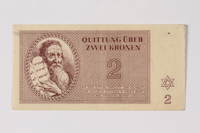
Theresienstadt ghetto-labor camp scrip, 2 kronen note, saved by a former German Jewish inmate
Object
Theresienstadt scrip, value 2 [zwei] kronen, acquired by Alfred Fabian, an inmate in Theresienstadt ghetto-labor camp in German occupied Czechoslovakia from March 1943-October 1944. Currency was confiscated from deportees and the SS ordered the Jewish Council to create a currency for exchange only in the camp. This was to create an illusion of normalcy and there was little to buy. On May 17, 1943, Alfred, wife Ruth, 5 year old daughter Ingrid, and Alfred’s mother Erna were deported to Theresienstadt. On October 12, 1944, the family was sent to Auschwitz-Birkenau killing center, where Ruth, Ingrid, and Erna were gassed on arrival. On November 19, 1944, Alfred was sent to Niederorschel slave labor camp, a Buchenwald subcamp in Germany. Niederorschel was evacuated on April 1, 1945. Alfred was sent to Buchenwald where he was liberated April 11 by the 761st Tank Battalion, US Army.
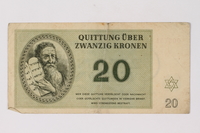
Theresienstadt ghetto-labor camp scrip, 20 kronen note, saved by a former German Jewish inmate
Object
Theresienstadt scrip, value 20 [zwanzig] kronen, acquired by Alfred Fabian, an inmate in Theresienstadt ghetto-labor camp in German occupied Czechoslovakia from March 1943-October 1944. Currency was confiscated from deportees and the SS ordered the Jewish Council to create a currency for exchange only in the camp. This was to create an illusion of normalcy and there was little to buy. On May 17, 1943, Alfred, wife Ruth, 5 year old daughter Ingrid, and Alfred’s mother Erna were deported to Theresienstadt. On October 12, 1944, the family was sent to Auschwitz-Birkenau killing center, where Ruth, Ingrid, and Erna were gassed on arrival. On November 19, 1944, Alfred was sent to Niederorschel slave labor camp, a Buchenwald subcamp in Germany. Niederorschel was evacuated on April 1, 1945. Alfred was sent to Buchenwald where he was liberated April 11 by the 761st Tank Battalion, US Army.
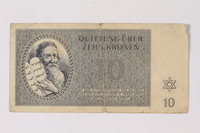
Theresienstadt ghetto-labor camp scrip, 10 kronen note, saved by a former German Jewish inmate
Object
Theresienstadt scrip, value 10 [zehn] kronen, acquired by Alfred Fabian, an inmate in Theresienstadt ghetto-labor camp in German occupied Czechoslovakia from March 1943-October 1944. Currency was confiscated from deportees and the SS ordered the Jewish Council to create a currency for exchange only in the camp. This was to create an illusion of normalcy and there was little to buy. On May 17, 1943, Alfred, wife Ruth, 5 year old daughter Ingrid, and Alfred’s mother Erna were deported to Theresienstadt. On October 12, 1944, the family was sent to Auschwitz-Birkenau killing center, where Ruth, Ingrid, and Erna were gassed on arrival. On November 19, 1944, Alfred was sent to Niederorschel slave labor camp, a Buchenwald subcamp in Germany. Niederorschel was evacuated on April 1, 1945. Alfred was sent to Buchenwald where he was liberated April 11 by the 761st Tank Battalion, US Army.
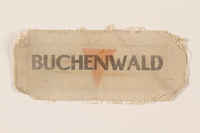
Cloth patch printed Buchenwald over a red inverted triangle worn by a German Jewish man
Object
Buchenwald prisoner badge worn by Alfred Fabian in Niederorschel and Buchenwald concentration camps from November 19, 1944, to April 11, 1945. The inverted red triangle on the badge signifies a political prisoner. On May 17, 1943, Alfred, wife Ruth, 5 year old daughter Ingrid, and Alfred’s mother Erna were deported to Theresienstadt ghetto-labor camp in Czechoslovakia. On October 12, 1944, the family was sent to Auschwitz-Birkenau killing center, where Ruth, Ingrid, and Erna were gassed on arrival. On November 19, 1944, Alfred was sent to Niederorschel slave labor camp, a Buchenwald subcamp in Germany. Niederorschel was evacuated on April 1, 1945. Alfred was sent to Buchenwald where he was liberated April 11 by the 761st Tank Battalion, US Army.
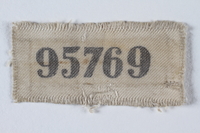
Prisoner ID badge number 95769 worn by a German Jewish man
Object
Prisoner identification patch worn by Alfred Fabian in Niederorschel and Buchenwald concentration camps from November 19, 1944, to April 11, 1945, printed with his prisoner number, 95769. On May 17, 1943, Alfred, wife Ruth, 5 year old daughter Ingrid, and Alfred’s mother Erna were deported to Theresienstadt ghetto-labor camp in Czechoslovakia. On October 12, 1944, the family was sent to Auschwitz-Birkenau killing center, where Ruth, Ingrid, and Erna were gassed on arrival. On November 19, 1944, Alfred was sent to Niederorschel slave labor camp, a Buchenwald subcamp in Germany. Niederorschel was evacuated on April 1, 1945. Alfred was sent to Buchenwald where he was liberated April 11 by the 761st Tank Battalion, US Army.
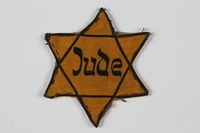
Star of David badge with Jude worn by a German Jewish man
Object
Star of David badge printed Jude, German for Jew, worn by Alfred Fabian in Berlin, Germany, from September 1941 to May 1943. On September 1, 1941, Jews were required to wear these badges to humiliate and separate them from the general public. On May 17, 1943, Alfred, wife Ruth, 5 year old daughter Ingrid, and Alfred’s mother Erna were deported to Theresienstadt ghetto-labor camp in Czechoslovakia. On October 12, 1944, the family was sent to Auschwitz-Birkenau killing center, where Ruth, Ingrid, and Erna were gassed on arrival. On November 19, 1944, Alfred was sent to Niederorschel slave labor camp, a Buchenwald subcamp in Germany. Niederorschel was evacuated on April 1, 1945. Alfred was sent to Buchenwald where he was liberated April 11 by the 761st Tank Battalion, US Army.
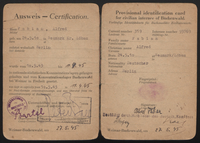
Alfred Fabian papers
Document
The Alfred Fabian papers consist of identification papers and photographs documenting Holocaust survivor Alfred Fabian, the Buchenwald camp, family members who perished in the Holocaust, and Fabian’s immigration to the United States. Identification papers include Fabian’s provisional identification card for civilian internees of Buchenwald and his Hebrew Immigrant Aid Society identification certificate. Photographs depict a pile of corpses at Buchenwald, Weimar citizens on a forced visit to the liberated camp, flags in front of a sign expressing the gratitude of liberated Czechoslovakian Buchenwald survivors, and a memorial stone for the Fabian family including Siegfried, Erna, Ruth, Ingrid, Siegbert, and Margot.



